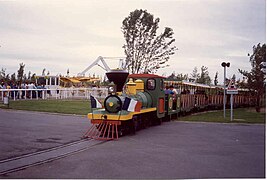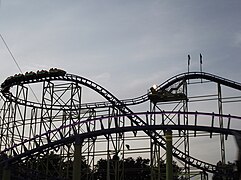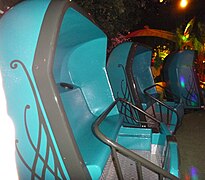Mirapolis
 The park seen from above, in 1987. In the background, the statue of Gargantua. | |
| Location | Courdimanche, Val-d'Oise, France |
|---|---|
| Coordinates | 49°03′13″N 2°00′01″E / 49.05361°N 2.00028°E |
| Status | Defunct |
| Opened | 21 May 1987 |
| Closed | 20 October 1991 |
| Owner | Paris-Parc Cergy-Parc Crédit national |
| Operating season | April–October |
| Attendance | 400 000[1][2] |
| Area | 35 ha (86 acres) (park) 20 ha (49 acres) (car park) |
| Attractions | |
| Total | 20-50 |
| Roller coasters | 3 |
| Water rides | 5 |

Mirapolis was a theme park located in Courdimanche (Val-d'Oise, France), which was based on elements from French literature (novels and fables) and culture.
Mirapolis was opened in 1987. Spanning 55 ha (136 acres), the park was described as being 'France's first large amusement park'. It encountered several problems, like other contemporary French parks, such as Zygofolis or Big Bang Schtroumpf.[3] Mirapolis eventually closed in 1991, and was mostly demolished.
History
[edit]Development
[edit]Mirapolis was originally the idea of the architect Anne Fourcade. Sodex Parc and the Banque arabe internationale d'investissement set up financial arrangements for the main investor, Saudi businessman Ghaith Pharaon.
Inspired by the big theme parks of the time, such as Disneyland, Mirapolis was to be one of the first French theme parks, and it was to be based on French tales and novels. The park would be dominated by a huge statue of Gargantua, inside which a dark ride attraction would be installed.[4][5]
Opening
[edit]Mirapolis was inaugurated on 20 May 1987 by Jacques Chirac, who was Prime Minister at the time. The park included 20 attractions, 3,000 restaurant seats, 13 shops and 12 food kiosks; it was able to welcome 28,000 visitors a day. It was split into 8 themed areas.
In 1988, the famous singer Carlos becomes sponsor of the park.[6]
The first year, bad weather caused problems for outdoor events, and people often took refuge in the "Grand Théâtre". Tens of thousands of people saw a children's musical, "Partir à point", with lyrics and music by René-Louis Baron. It was a comic mixture of the works of Jean de La Fontaine using a staging of giant puppets created by Yves Brunier (creator of the giant puppet "Casimir").
Closure, demolition and abandonment
[edit]The park was closed in 1991 having never made a profit. Expectations of profitability had been overly optimistic and based on incorrect market research. Mirapolis may also have suffered from its complex theming (diluted in 1989 with funfair attractions), its image and its high upkeep.
Starting in 1993, the majority of the buildings were demolished. Some attractions were sent to other amusement parks. Dragon des Sortilèges went to Spreepark, as well as Miralooping. Miralooping is now at Europark. Les pirates went to Meli Park, which in 2000 reopened as Plopsaland. On 1 September 1995, after the partial and controversial[7] dismantling of the Gargantua statue, the head was finally dynamited.
In 1994, the road alignment near Mirapolis was modified. The entrance square was made into a roundabout. The two main sections of the car park were made into a road and extended, forming the Boulevard des Merveilles in the Cergy-le-Haut area.
The inside of the park was abandoned. Only a few buildings endure: the gates and their elephant heads, the concrete building at the entrance, the former store, the small kiosk of the Observatoire and the Mur Vauban. The car parks were also abandoned, and are now partially hidden by vegetation.
Sometimes the park is used by the National Gendarmerie and the GIGN for manoeuvres.[8]
On 20 May 2017, to celebrate the 30th anniversary of the opening of the park, the association 'Mirapolis, les amis du parc' set up an exhibition in the Salle Georges Brassens of Menucourt, retracing the history of Mirapolis with the help of photographs, models and items.[9]
Reconversion
[edit]The building of a touristic ecodistrict was expected in 2018 on the former site of Mirapolis.[10]
Gallery
[edit]-
Dame tartine
-
Dragon des Sortilèges, now at Spreepark (Germany)
-
Rivière des castors and bateau pirate
-
Mirapolis express
-
Miralooping, now at Europark (France)
-
Les pirates, now at Plopsaland (Belgium)
-
Voyage sous la mer, now at Europa-Park (Germany)
See also
[edit]References
[edit]- ^ "Dernier tour de manège pour Mirapolis", Les Echos, France, 18 December 1991
- ^ Flament, Émile (1993). "Quelques observations sur les grands parcs d'attractions en France". Hommes et Terres du Nord. 2. Université de Picardie Jules-Verne Laboratoire de géographie humaine USTL: 74–77. doi:10.3406/htn.1993.2418. Retrieved 23 May 2020.
- ^ C., Ph. (8 April 1992). "Après un véritable engouement à la fin des années 80, la douche froide provoquée par plusieurs échecs retentissants..." Les Echos. France. Retrieved 20 May 2017.
- ^ Meillon, Jacqueline (13 November 1986). "Mirapolis, parc à la française". Le Monde. Retrieved 20 May 2017.
- ^ M6 (3 November 2013). "Mirapolis Capital M6". Dailymotion. Retrieved 20 May 2017.
{{cite web}}: CS1 maint: numeric names: authors list (link) - ^ Gavi, Philippe (10 June 1988). "Mirapolis, la ville dont le prince est un enfant" (PDF). L'Obs. Retrieved 20 May 2017.
- ^ Vanweydeveldt, Lucile (29 August 1995). "Gargantua terrassé par le Crédit national. Le propriétaire de Mirapolis, fermé en 1992, va démolir le géant d'ici dimanche". Libération. Retrieved 20 May 2017.
- ^ Biry-Vicente, Rafaela (10 February 2015). "PORTRAIT – Un couple de Nordistes passionnés par un parc d'attractions fermé depuis vingt ans". France Bleu. Retrieved 20 May 2017.
- ^ Ménard, Julie (19 May 2017). "Menucourt : 30 ans après, Mirapolis revit le temps d'une expo". Le Parisien. Retrieved 20 May 2017.
- ^ Persidat, Marie (16 December 2016). "Courdimanche : " la création de cet éco-village est une chance "". Le Parisien. Retrieved 20 May 2017.
Bibliography
[edit]- More information in the French magazine Dixième Planète n° 42 (August–September 2006).







